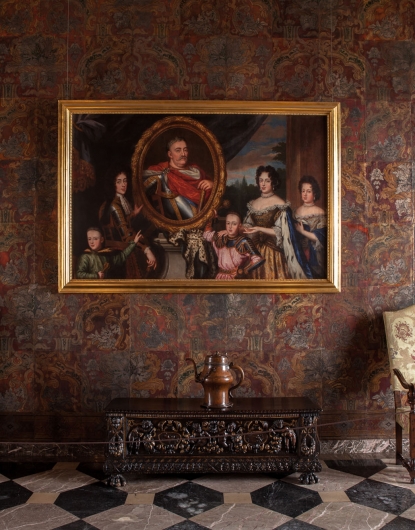
State Rooms
The main exhibition of the castle’s interiors includes apartments on the second floor (currently ten room are on view.)
The floor referred to as piano nobile, which contained the official rooms, was most often located in the first story of a palace, however, in the case of Wawel Castle it is located on the second story. The rooms are noticeably higher and more spacious in relation to those on the lower floors, and were intended for state functions. Sessions of the sejm and senate, royal audiences, and wedding receptions and balls were held in these grand rooms. Following a catastrophic fire in 1595, the east and north wings of the Renaissance palace built by the Jagiellons were rebuilt in the early Baroque style by architect Giovanni Trevano for King Sigismund III. Consequently, this part of the palace has Baroque furnishings.
In other interiors among the objects that survived are marble portals and a magnificent early Roman Baroque fireplace, as well as stucco ceilings, such as those in the royal chapel. The present reproduction Baroque ceilings, from the inter-war period, are filled with plafonds by then noted Polish painters-colourists of the time, and the walls are covered with 18th century cordovan tapestries. The Dutch Study in Sigismund III’s Tower houses paintings of the Dutch school. Portraits of Polish kings and members of the royal families, as well as paintings of historic moments in Poland’s past, are the dominant feature in this section of the castle.
Tapestries commissioned by Sigismund Augustus are the most valuable treasure of the Renaissance rooms, and the only art object preserved from the original interior decoration. Woven in Brussels in the third quarter of the 16th century, they depict biblical and grotesque scenes, and the coats of arms of Poland and Lithuania. There are also valuable paintings, Italian furniture, predominantly from 16th century Tuscany, and Polish royal portraits.
The floor referred to as piano nobile, which contained the official rooms, was most often located in the first story of a palace, however, in the case of Wawel Castle it is located on the second story. The rooms are noticeably higher and more spacious in relation to those on the lower floors, and were intended for state functions. Sessions of the sejm and senate, royal audiences, and wedding receptions and balls were held in these grand rooms. Following a catastrophic fire in 1595, the east and north wings of the Renaissance palace built by the Jagiellons were rebuilt in the early Baroque style by architect Giovanni Trevano for King Sigismund III. Consequently, this part of the palace has Baroque furnishings.
In other interiors among the objects that survived are marble portals and a magnificent early Roman Baroque fireplace, as well as stucco ceilings, such as those in the royal chapel. The present reproduction Baroque ceilings, from the inter-war period, are filled with plafonds by then noted Polish painters-colourists of the time, and the walls are covered with 18th century cordovan tapestries. The Dutch Study in Sigismund III’s Tower houses paintings of the Dutch school. Portraits of Polish kings and members of the royal families, as well as paintings of historic moments in Poland’s past, are the dominant feature in this section of the castle.
Tapestries commissioned by Sigismund Augustus are the most valuable treasure of the Renaissance rooms, and the only art object preserved from the original interior decoration. Woven in Brussels in the third quarter of the 16th century, they depict biblical and grotesque scenes, and the coats of arms of Poland and Lithuania. There are also valuable paintings, Italian furniture, predominantly from 16th century Tuscany, and Polish royal portraits.
Tournament Room

It was presumably here that sessions of the royal council took place. The room owes its name to the subject of frieze, painted in the 1540s by Hans Dürer, brother of the famous Albrecht, and Anton Wiedt of Breslau.
The Renaissance furnishings include Italian cabinets and chests, Italian-style armchairs, and Sicilian maiolica vases. The 18th-century tiled stove comes from the palace at Wiśniowiec and was brought to Wawel Castle during its restoration in the early 1900s.
Military Review Vestibule
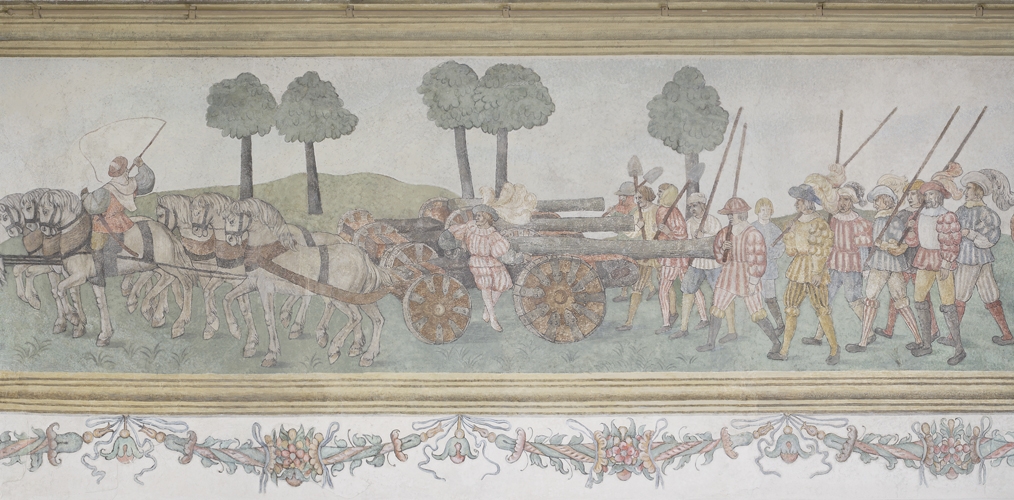
This room is a former vestibule once entered from the galleries. From here one could access the study in the Jordanka Tower, the adjoining state rooms, as well as the internal stairwell leading to the gardens. The Renaissance frieze, to which the chamber owes its name, presents a military parade. It was painted by Anton Wiedt of Breslau. Of particular note are the portraits of King Sigismund I and his daughter, Anna Jagiellon, as well as the portrait of Gian Giacomo Caraglio, court goldsmith and armourer to King Sigismund II Augustus. The tapestries from the king’s collection are also notable.
Study in the Jordanka Tower
This room is in the Gothic defense tower known as the Jordanka Tower, which was added on in the 16th century. Two precious sets of Renaissance maiolica Italian tin-glazed earthenware are displayed in the vitrines.
Envoys Hall
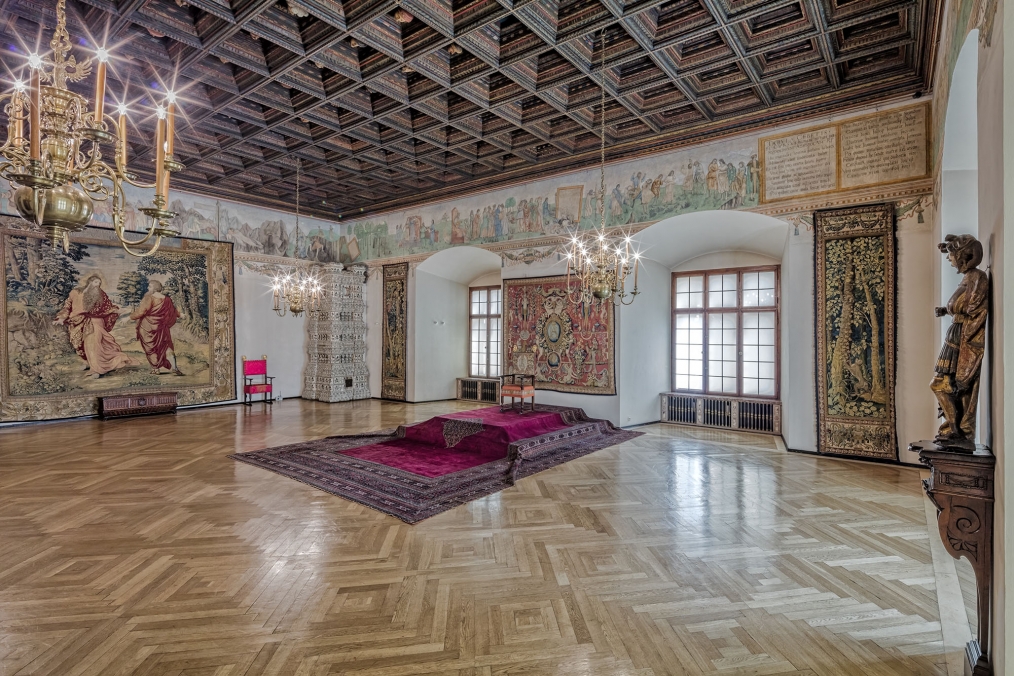
One of the two largest rooms in the palace. Sessions of the sejm were held here, and in the 16th century it was also used as a throne room, presence chamber, and court room. In the second half of the century, it also functioned as a ball room. Among others, the festivities that accompanied the coronation of Henri de Valois as king of Poland (later Henri III of France), and the wedding of Sigismund III were held here. It is also known as the Heads Hall, for the coffered ceiling is adorned with 30 sculpted heads (all that survive of the original 193) made in about 1540 by the Breslau masters Sebastian Tauerbach and Hans the Woodcarver.
The frieze dates from the same period. Painted by Dionizy Stuba, it illustrates The History of Human Life according to a text ascribed to Cebes of Thebes.
Zodiac Room

In the 16th century this was a part of an apartment intended for royal guests. It owes its present name to the frieze by Leonard Pękalski from 1929, on which are presented the signs of the zodiac. It is known that the earlier Renaissance frieze was the work of Hans Dürer. The room’s furnishings include Brussels tapestries and copper wine coolers placed on Italian chests.
Planet Room
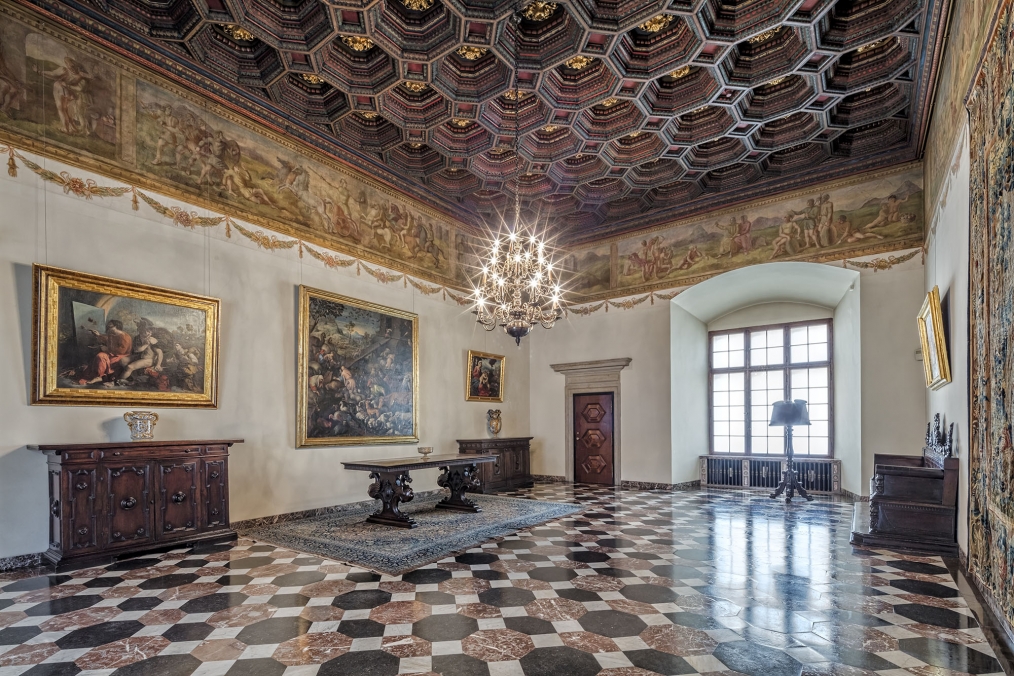
The room’s present name derives from the personifications of the planets depicted on the frieze painted in 1929 by Leonard Pękalski
The Battle of Orsha Vestibule
The vestibule, accessible from the galleries, leads to the apartments situated in the Danish Tower and the chambers located in the north wing of the castle. The present name refers to the 1929 frieze painted by Leonard Pękalski which depicts the victory of the Polish-Lithuanian forces at the Battle of Orsha in 1514.
The chamber is dwarfed by the monumental Battle of Lepanto by Tommaso Dolabella, the court painter to Sigismund III. The remaining pictures – formal portraits of important personages of the former Polish--Lithuanian Commonwealth – are examples of the Old Polish school of portraiture.
Collector’s Cabinet
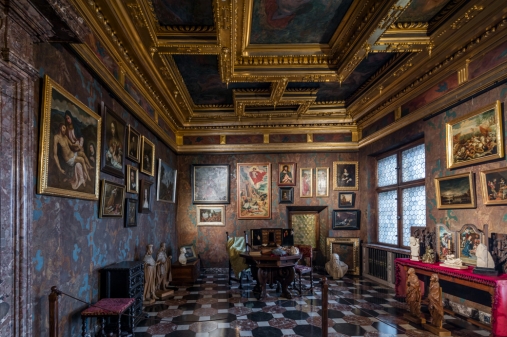
The display relates to the historical collectors’ cabinet, or Kunstkammer, speaks to the collecting passion of the Vasa kings – Sigismund III and his son Ladislas IV. The painted and embossed gilt-leather wall coverings, provide a sumptuous backdrop for the works of art and curiosities of nature traditionally assembled in such places.
Bird Room
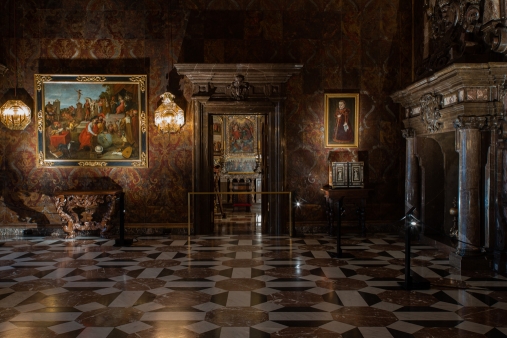
In the 16th century the room functioned as a throne room and a presence chamber, to which the chair placed on the dais alludes. It was rebuilt after the fire of 1595, and from this period derive the majestic chimney piece with the coat of arms of Poland and the Vasa dynasty Sheaf being the work of Ambrogio Meazzi. We know that at this time, around the year 1600, the room was adorned with metal birds suspended from the ceiling, hence the present name. The birds on the frieze that runs round the room are also a reference to this fact. The original ceiling paintings by Tommaso Dolabella were destroyed in the fire of 1702; the present-day painting is the work of Felicjan Szczęsny Kowarski of 1929.
Chapel
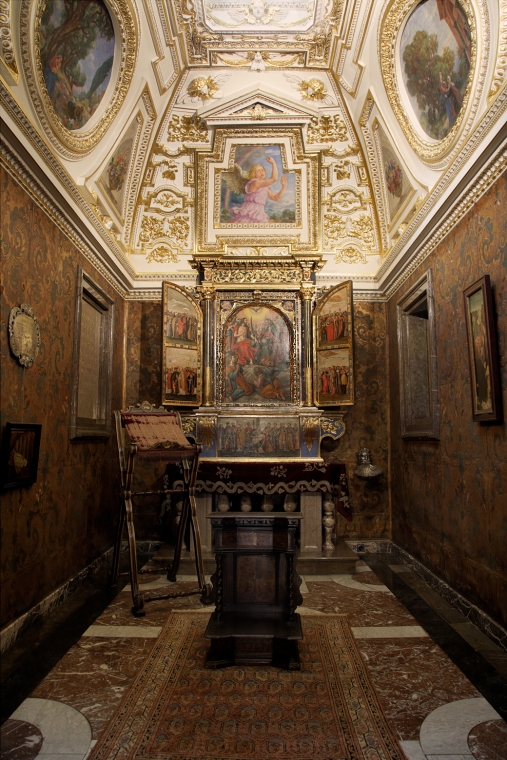
Giovanni Trevano built this private chapel for King Sigismund III in 1602. The preserved original Baroque stucco work was supplemented with decorative paintings by Józef Pankiewicz, which he executed in 1931. The altarpiece, in the form of a triptych with a depiction of the Holy Trinity, comes from the Krakow Dominican church at Gródek.
Dutch Study
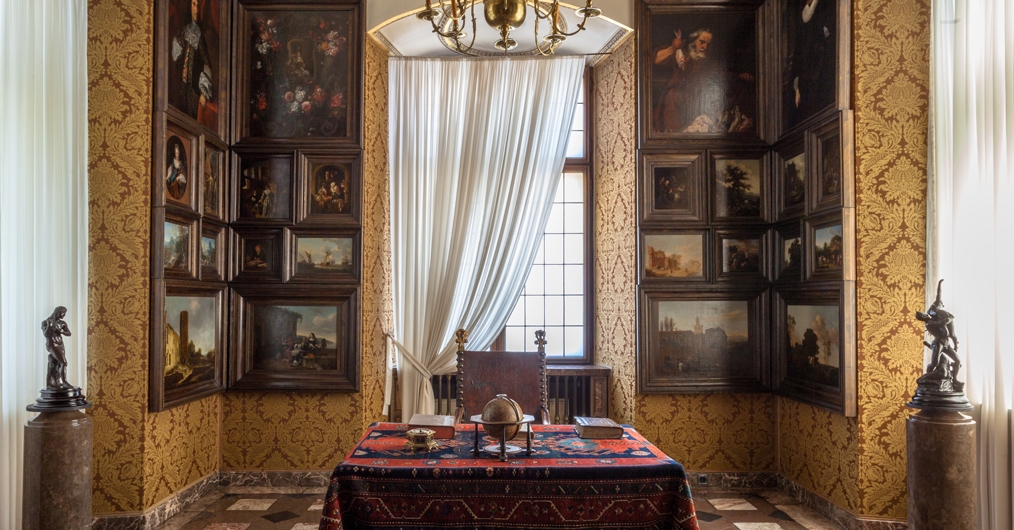
This small study in the Sigismund III Tower has retained the stucco work decoration of the vault, and the flooring. The collection of paintings reflects the collecting preferences of Polish kings of the Vasa dynasty. The vestibule walls are decorated with 18th-century gilt leather.
Vestibule beyond the Bird Room
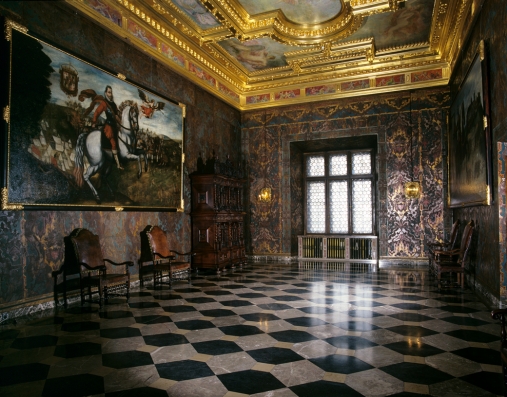
Initially, in the 1530s, the room may have been used by the secretaries of Sigismund I the Old. They could have used the adjoining internal stairwell which joined the vestibule with the royal chancery located in the treasury on the ground floor of the Castle. Towards the end of the 16th century the room was part of the apartment of Anne of Austria, queen of Poland, and her son Prince Ladislas. The painted ceilings, reconstructed during the restoration carried out in the inter-war period, hold pictures by Lucjan Adwentowicz
Eagle Room
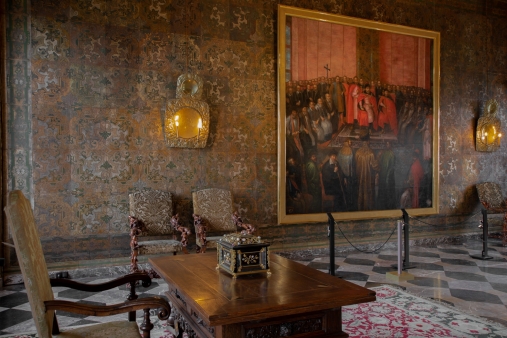
In the 16th century it was called the grand chamber (stuba magna), in which the royal courts presided.
During the wedding of King Sigismund I and Bona Sforza it served as the royal state bedchamber. After
1595, it received a new ceiling with a magnificent carved Eagle, which was to be destroyed by fire in 1702.
The present-day ceiling is supplemented by the painting of Leonard Pękalski from 1933–1934, depicting,
among others, Józef Piłsudski commanding the Polish Legions.
Vestibule before the Senators’ Hall
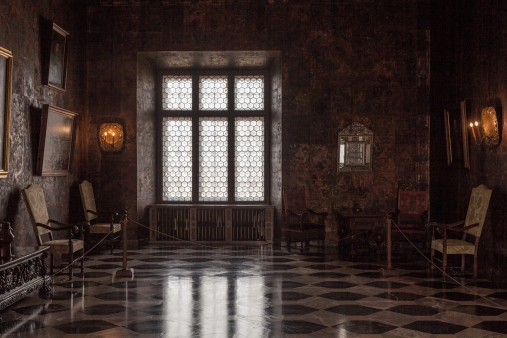
The ceiling is adorned with the paintings of Józef Jarema and his collaborators from the 1930s. The furnishings comprise Italian armchairs and chests. The paintings displayed in the room relate to the history of the Polish-Lithuanian Commonwealth in the 17th century.
Senators’ Hall
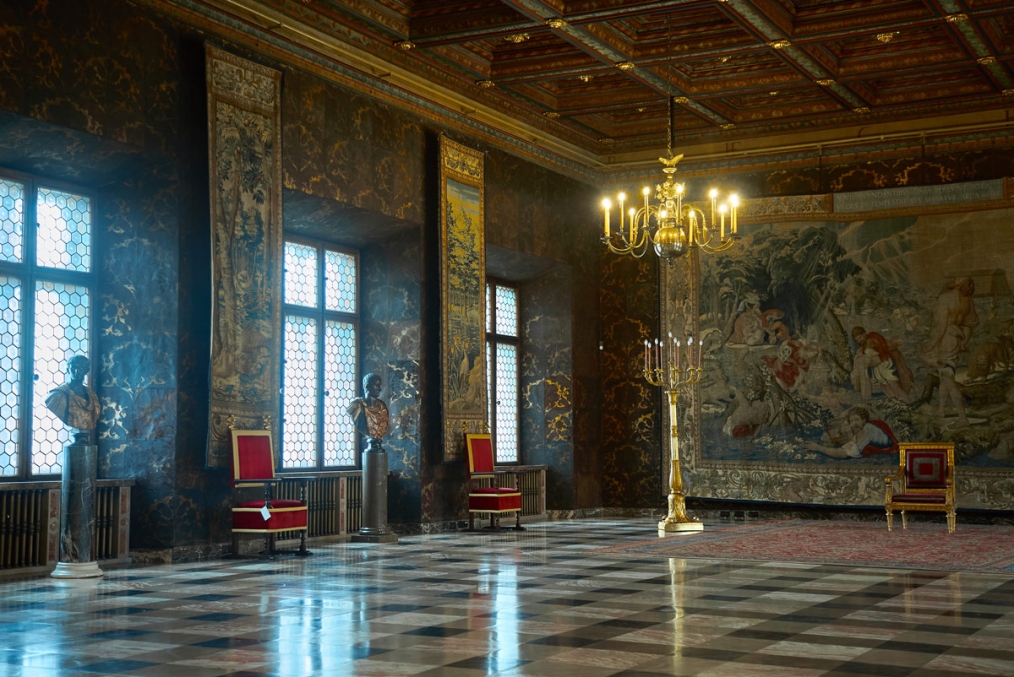
This imposing state room was referred to in primary sources as aula superior or stuba magna. Here were held the state openings of the sejm and sessions of the senate, the upper house of parliament. The room was also used for balls and theatrical spectacles during royal weddings – for the first time in 1518 during the wedding of Bona Sforza and Sigismund I. The musicians’ gallery was added in 1592. The exit leads to one of the main stairwells, known as the Senators’ or Royal staircase.
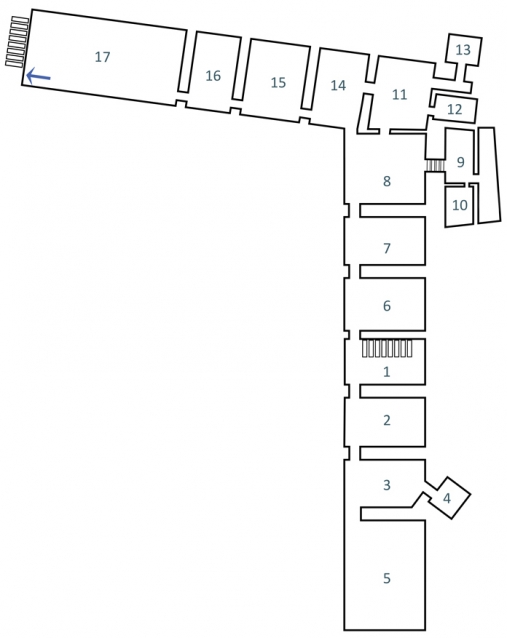
1. Entrance Hall to the Envoys Stairs
2. Tournament Room
3. Military Review Vestibule
4. Study in the Jordanka Tower
5. Envoys Hall
6. Zodiac Room
7. Planet Room
8. The Battle of Orsha Vestibule
9. Collector’s Cabinet
10. Red Cabinet
11. Bird Room
12. Chapel
13. Dutch Study
14. Vestibule beyond the Bird Room
15. Eagle Room
16. Vestibule before the Senators’ Hall
17. Senators’ Hall
